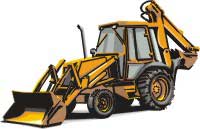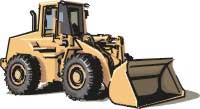|
Backhoe & Loader Safety |
|
Lance Fluegel and Bradley Rein
SafetyInfo.com
|
|
BEFORE USING THE MACHINE
- Read the owner's manual to learn the characteristics of your machine.
- For your personal
protection you will need to wear some or all of the following:

- sturdy pants and shirt,
- safety shoes,
- hard hat,
- safety goggles or glasses,
- gloves,
- hearing protection, and
- respirator
for dusty conditions.
- Sunscreen protection is vital in bright sunshine if not under a roof.
- Check the loader/backhoe
for the presence of the following safety devices in good working order:
- rollover protective structure (ROPS),
- seat belt (if ROPS equipped),
- guards,
- shields,
- backup warning system,
- lights, and mirrors.
- Fill the fuel tank while engine is off and cool. Never fill inside a building. Do not smoke. Wipe up any spills immediately.
- Check the machine daily for broken, missing, or damaged parts. Make the necessary repairs or replacements.
- Keep the machine clean -- especially steps, hand rails, pedals, grab irons, and floor of the cab. Slippery surfaces are very hazardous.
- Remove or secure loose items in the cab that could interfere with operating the controls.
- Check the work area for hidden holes, obstacles, drop-offs, etc. Clear children, pets, and bystanders from the area.
- Check overhead for utility lines, roofs, and other obstacles.
- Request Blue Stake service to locate underground cables, gas lines, water, and sewer lines before digging. You need to request this service in advance.
- Always use the hand rails, ladders, and steps provided when mounting the machine; never grab controls or the steering wheel.
- The cab was designed for one person -- allow no riders, especially children.
OPERATING THE LOADER
 |
|
OPERATING THE BACKHOE
- Keep the loader bucket on the ground.
- Level the machine for maximum stability.
- Operate the backhoe only from the seat.
- Never swing the bucket over a truck cab.
- Dump the bucket uphill if possible when operating on a slope. If you must dump downhill swing slowly to avoid tipping the machine.
- If using the backhoe as a hoist, do so with the weight over the back of the machine -- NEVER THE SIDE -- to avoid tipping.
- Be sure the load you are lifting is balanced, and move the boom slowly to avoid swaying the load.
SAFE STOPPING PROCEDURE
- Park the machine on level ground if possible and set the parking brake. Place transmission in park if so equipped.
- Lower the loader and backhoe buckets to the ground.
- Stop the engine and remove the key.
- Work the hydraulic controls to relieve pressure.
- Wait until all motion has stopped and then dismount carefully using steps and safety holds.
- Do not jump from the machine.
![]()
This paper appears in the eLCOSH website with the permission of the author
and/or copyright holder and may not be reproduced without their consent.
eLCOSH is an information clearinghouse. eLCOSH and its sponsors are not
responsible for the accuracy of information provided on this web site,
nor for its use or misuse.
![]() eLCOSH
| CDC | NIOSH
| Site Map | Search
| Links | Help
| Contact Us | Privacy Policy
eLCOSH
| CDC | NIOSH
| Site Map | Search
| Links | Help
| Contact Us | Privacy Policy
